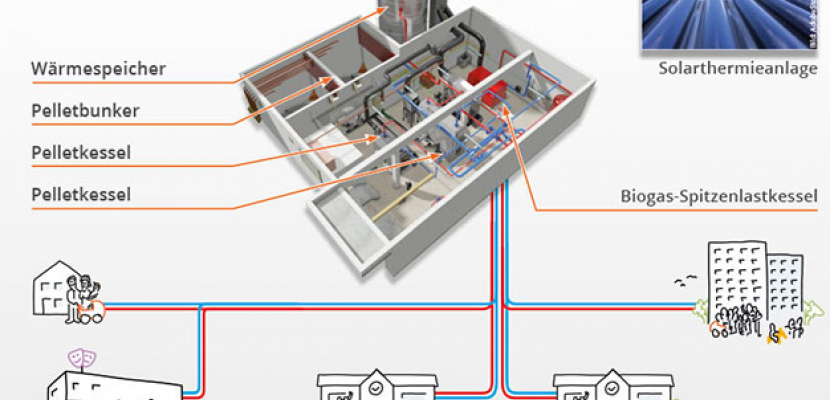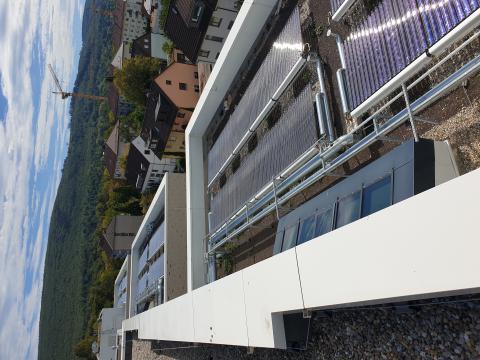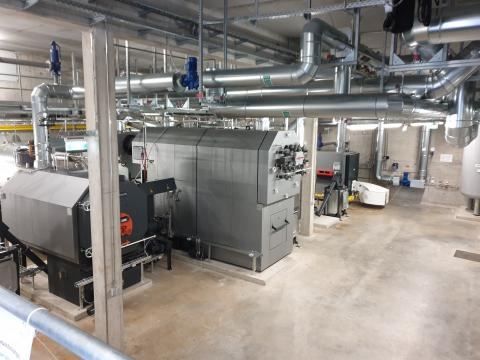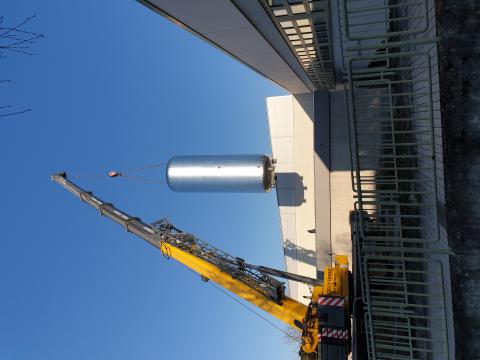
Renewable local district heating: Musikerviertel Ettlingen

About this good practice
The energetic refurbishment of the vocational school centre (BBZ) of the Karlsruhe district provided the origin for the project. In addition, several new buildings (apartment buildings, kindergarten) were constructed in the neighbourhood and further residential buildings from the 1950s and 1960s needed renovation. Their heat supply was mainly provided by the existing natural gas network.
The goal was a heat supply with a maximum possible share of renewable energy. The advantages for new and existing buildings:
- low primary energy factor
- economical alternative to individual heating, low personal investment
- Contribution to climate protection goals
The new heating system with two wood pellet boilers (1,250 and 540 kW), a biogas boiler (2,000 kW) and a solar thermal system (150 kW) on the roof of the new school building replaces the previous gas and oil heating systems and saves around 1,800 tonnes of CO2 annually. The heat is distributed via about 1,600 metres of heating pipelines. So far, various consumers have been connected with about 4,000 kW of heating demand capacity, which means that about 65% of the installed production capacity is being used.
The cooperation between the district, the city and the municipal utility under the coordination of the Environment and Energy Agency was exemplary throughout the project. The project is part of the municipal heating scheme of the city of Ettlingen, which aims for a carbon-free heating sector by 2050.
Expert opinion
District heating brings numerous benefits to communities in which it is implemented, including lower maintenance costs, greater safety compared to individual heating systems, typically cheaper heating bills, and if used with renewable energy, new green jobs and energy security. When used with renewable technologies they are high effective at cutting carbon emissions, as well as being cost effective. This is a very strong example of a renewable district heating system, making use of multiple technologies and renewable resources (biomass, biogas, solar thermal) with an impressive level of CO2 reduction.
Resources needed
Total Investment: approx. 6 Mio. EUR;
Funding approx. 4 Mio. EUR.
Evidence of success
15 buildings connected by heat substations: Vocational training centre (BBZ), multi-family houses/condominiums (approx. 210 dwellings) private multi-family houses (approx. 10 dwellings);
primary energy factor: approx. 0.4;
100% regenerative energy supply; approx. 85% CO2 emissions avoided (compared to previous situation).
Potential for learning or transfer
District Heating (DH) provides a good opportunity to switch over to a renewable heat supply for substantial numbers of buildings.
An “anchor customer” with a larger heat demand is a good starting point for the development of a DH system in the surrounding area, which later can grow and even be connected to other DH grids. Early outreach to potential customers is crucial to obtain a “critical mass” of heat demand.
Renewable heat can be generated e.g. from solar thermal plants, wood chips or pellets, biogas, but also from waste heat
Usually, DH is economically feasible only on a medium to long term (often 15 years +), but due to the durability of the components it can be a very sustainable and profitable business model.
Further information
Project "CO2-free district heating Musikerviertel"
Images



